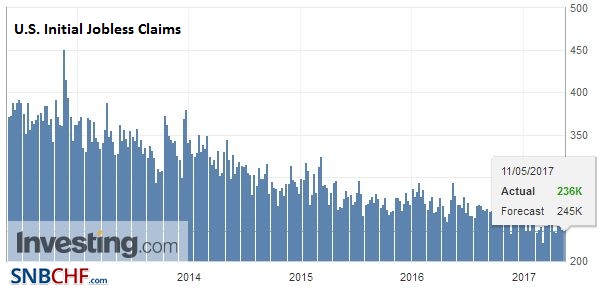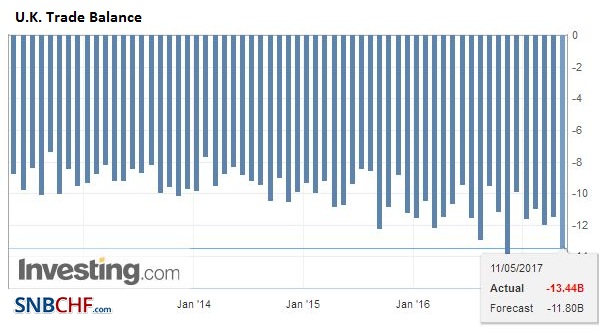Swiss Franc Switzerland Consumer Price Index (CPI) YoY, April 2017(see more posts on Switzerland Consumer Price Index, ) Source: investing.com - Click to enlarge FX Rates The US dollar has been mostly confined to about a 30 pip range against the euro and yen in Asia and the European morning. Sterling is under a little pressure after a series of poor data, including larger than expected falls in manufacturing and construction output, and a sharp widening of the trade deficit. However, here too ranges are narrow as the outcome of the Bank of England meeting is awaited. The New Zealand and Canadian dollars are stealing the foreign exchange show today. The New Zealand dollar sold off hard after the central bank softened its inflation forecast and discouraging speculation in the market of a rate hike. Officials played up the downside risks. The Kiwi was sold to fresh lows since last June. It is off 1.3%, the most since the US election last November. A break of %excerpt%.6800 could spur a move toward %excerpt%.6650. The Canadian dollar was spanked after Moody’s downgraded six banks amid concern about exposure to an overstretched consumer. The Canadian dollar had staged a recovery in North America yesterday and finished the session near the lower end of its recent range (~CAD1.3640).
Topics:
Marc Chandler considers the following as important: AUD, CAD, EUR, EUR/CHF, Featured, FX Daily, FX Trends, GBP, Japan Current Account n.s.a., Korea, newslettersent, NZD, U.K. industrial production, U.K. Manufacturing Production, U.K. trade balance, U.S. Initial Jobless Claims, U.S. Producer Price Index, USD
This could be interesting, too:
Nachrichten Ticker - www.finanzen.ch writes Die Performance der Kryptowährungen in KW 9: Das hat sich bei Bitcoin, Ether & Co. getan
Nachrichten Ticker - www.finanzen.ch writes Wer verbirgt sich hinter der Ethereum-Technologie?
Marc Chandler writes March 2025 Monthly
Mark Thornton writes Is Amazon a Union-Busting Leviathan?
Swiss Franc |
Switzerland Consumer Price Index (CPI) YoY, April 2017(see more posts on Switzerland Consumer Price Index, ) Source: investing.com - Click to enlarge |
FX RatesThe US dollar has been mostly confined to about a 30 pip range against the euro and yen in Asia and the European morning. Sterling is under a little pressure after a series of poor data, including larger than expected falls in manufacturing and construction output, and a sharp widening of the trade deficit. However, here too ranges are narrow as the outcome of the Bank of England meeting is awaited. The New Zealand and Canadian dollars are stealing the foreign exchange show today. The New Zealand dollar sold off hard after the central bank softened its inflation forecast and discouraging speculation in the market of a rate hike. Officials played up the downside risks. The Kiwi was sold to fresh lows since last June. It is off 1.3%, the most since the US election last The Canadian dollar was spanked after Moody’s downgraded six banks amid concern about exposure to an overstretched consumer. The Canadian dollar had staged a recovery in North America yesterday and finished the session near the lower end of its recent range (~CAD1.3640). Recall that since April 18, the Canadian dollar has fallen in all but three sessions. The news initially hit thin markets, and the US dollar quickly spiked toward the week’s high near CAD1.3750. The US dollar has drifted lower and in the European morning eased toward CAD1.3700. |
FX Daily Rates, May 11 |
| Sterling has been knocking on the $1.30 area for three of the past five sessions. There is a GBP320 mln option struck there that will be cut today. It fell to almost $1.29 in the European morning. Additional support is seen near $1.2880. A break of $1.2850 though would be the first indicator that the market may have given up on the $1.30 cap.
Some observers had been concerned that North Korea’s threat to test a nuclear missile would strengthen the yen, but the knee-jerk reaction had been minor. The dollar slipped to around JPY113.65 yesterday and closed near its session highs near JPY114.35. Consolidation is the main characteristic today, with a large ($1.3 bln) expiry of an option struck at JPY114.00 today. The dollar is slightly lower against the yen today. It has fallen in only three sessions since Macron won the first round of the French elections, or once a week for the third consecutive week. Like yesterday, the euro is spending today in the lower end of its range since April 24. There are roughly 2.7 bln euros of options struck at $1.0870 (~685 mln), $1.09 (~1.3 bln ) and $1.0925 (~842 mln). Interest rate differentials between the US and Germany are flat with both the 2-year and 10-year spreads hovering around 2.0%. Several technical considerations converge in the $1.0820-$1.0830 area. It is not just the yen that has shrugged off the threat by North Korea. The South Korean won is up 0.7% and is the second strongest emerging market currency today after the South African rand. Over the past five sessions, it is the only Asian currency to rise against the dollar. Korean shares rallied more than 1% to new record highs and helped lift the MSCI Asia-Pacific Index 0.3%. |
FX Performance, May 11 |
JapanJapan reported a larger than expected current account surplus for March. The JPY2.9 trillion surplus was the second largest since 1996. One of the most important characteristics of Japan’s current account surplus, which is not always understood, is that it does not primarily stem from the trade. Japan recorded a trade surplus on the balance of payments basis of JPY866 bln. Instead, the driver of Japan’s current account surplus is from the primary income account. Primary income includes coupons, dividends, and profits from overseas investments. A weak yen flatters the value of its overseas earnings, which in turn boost the current account. Due to different competitive strategies, and a host of other considerations, a weak yen, as Japan has experienced, does not necessarily translate into greater net exports. |
Japan Current Account, March 2017(see more posts on Japan Current Account n.s.a., ) Source: Investing.com - Click to enlarge |
United StatesThe Bank of England will overshadow the US report on producer prices. Tomorrow’s reports on the US CPI and retail sales are understood as more important. The US S&P 500 has been reached record highs in two of this week’s three sessions coming into today. However, note that it is up 0.34 points this week. The NASDAQ reached new record highs on Tuesday. It is up five consecutive sessions and seven of the past eight. It is up about 0.5% this week, which could be the fourth consecutive weekly advance. |
U.S. Producer Price Index (PPI), April 2017(see more posts on U.S. Producer Price Index, ) Source: Investing.com - Click to enlarge |
U.S. Initial Jobless Claims, April 2017(see more posts on U.S. Initial Jobless Claims, ) Source: Investing.com - Click to enlarge . |
|
United KingdomToday’s data was mostly disappointing, but it is for March, and with a softer than expected Q1 GDP already behind us, the new information was limited. Suffice it is to say that industrial output |
U.K. Industrial Production, March 2017(see more posts on U.K. Industrial Production, ) Source: Investing.com - Click to enlarge |
| and manufacturing fell each month in Q1, and the decline was more than anticipated. However, construction output was considerably worse than expected. The median from the Bloomberg survey was for a 0.4% rise, but instead, it fell 0.7%. |
U.K. Manufacturing Production, March 2017(see more posts on U.K. Manufacturing Production, ) Source: Investing.com - Click to enlarge |
| To round out the disappointed, the trade deficit swelled to GBP 4.9 bln. The median forecast was for a GBP 3 bln shortfall. Some offset was seen in the February shortfall that was revised to GBP 2.65 bln from GBP 3.66bln. |
U.K. Trade Balance, March 2017(see more posts on U.K. Trade Balance, ) Source: Investing.com - Click to enlarge |
The Bank of England meets today. It is widely expected to leave rates alone. However, Forbes, who dissented last time, is likely to dissent again. Her term is nearly up, and she likely was not able to convince any of her colleagues. Since the BOE’s quarterly inflation report in February, growth has been a bit slower than expected but inflation stronger. We anticipate that the base effect of sterling’s decline and energy prices will drop out of the year-over-year comparisons in Q3. This will likely take the sting from inflation and leave the economy soft
Graphs and additional information on Swiss Franc by the snbchf team.
Tags: #GBP,#USD,$AUD,$CAD,$EUR,EUR/CHF,Featured,FX Daily,Japan Current Account n.s.a.,Korea,newslettersent,NZD,U.K. Industrial Production,U.K. Manufacturing Production,U.K. Trade Balance,U.S. Initial Jobless Claims,U.S. Producer Price Index


